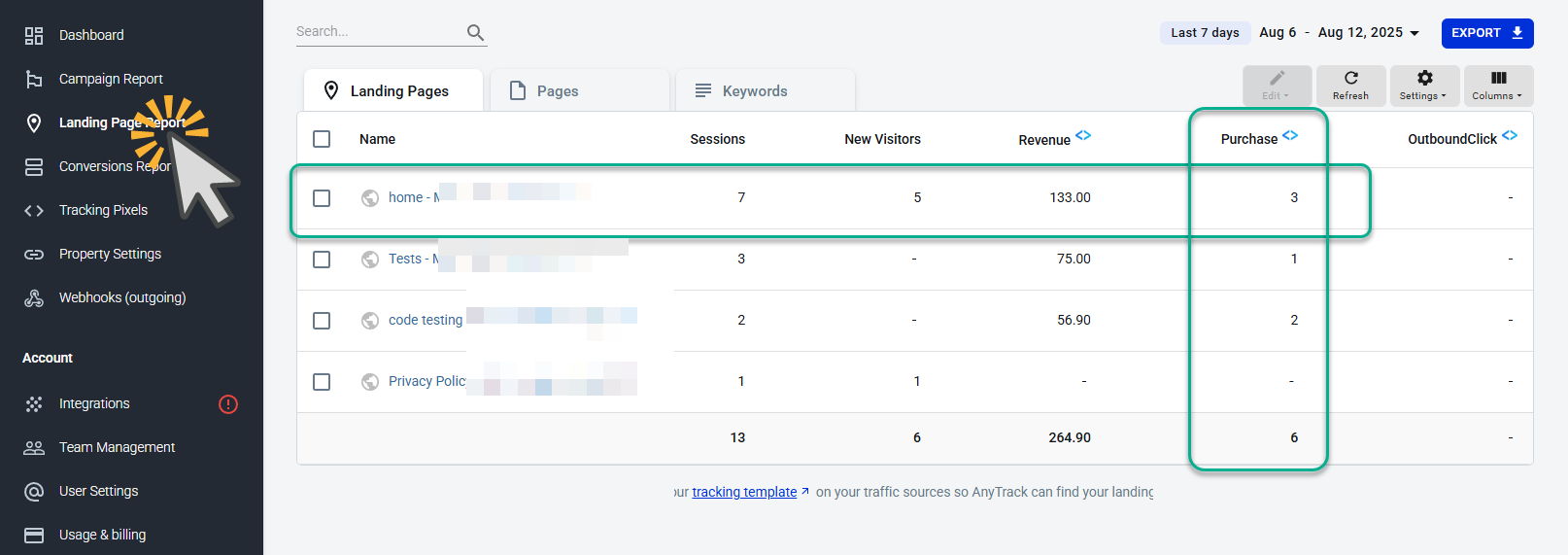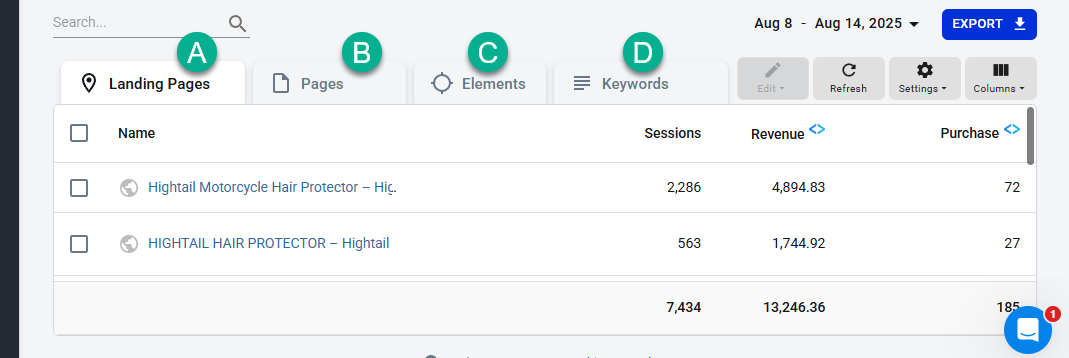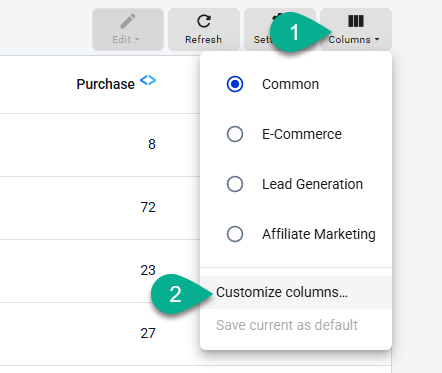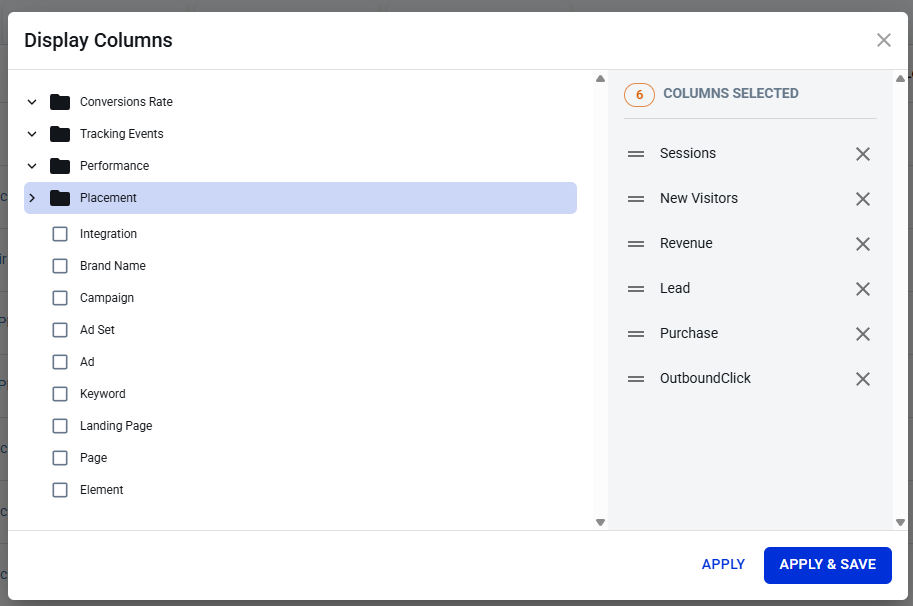Landing Page Report
Learn about the anytrack landing page report, how to use it and what metrics you can access.
The Landing Page Report in AnyTrack focuses on the first page visitors land on and lets you drill into what happens next—seeing subsequent pages viewed, interactions with tracked elements (like add-to-cart or sign-up), and the keywords that drove the visit—so you can judge how each entry page influences downstream behavior and conversions.

Use the Landing Page Report to identify the pages driving conversions and revenue on your site.
Sections
The Landing Page Report offers four views depending on how you want to break down performance:

A) Landing Pages. These are the first pages visitors hit when they arrive on your site from an ad, email, or other source. Metrics here focus on acquisition performance — sessions, new visitors, conversions tied to the initial entry point.
B) Pages. These are all pages on your site that get tracked traffic, no matter if they were the entry point or just part of the visitor’s journey. This view shows performance throughout the funnel, including pages people visit after the landing page.
C) Elements. Elements are tracked user interaction points or URLs (like buttons, forms, checkout steps, or specific paths) that aren’t necessarily full landing pages. They let you monitor performance for specific funnel steps or key site actions.
D) Keywords. Keywords are the search terms or ad keywords that drove traffic to your site, usually pulled from your ad platform’s tracking parameters (like Google Ads’ {keyword}).
Customization
Customize the report by adding dozens of columns from four categories: Conversion Rate, Tracking Events, Performance, and Placement.

Customize the report by adding, removing and ordering columns.

Select columns from four categories (Conversions Rate, Tracking Events, Performance and Placement).
Additional Information
The landing page report in the AnyTrack dashboard provides marketers with crucial insights into how their landing pages are performing, which helps optimize campaigns for better conversions. Here's what you should know about it based on the AnyTrack Knowledge Base and product overview:
Purpose: The landing page (or campaign) report helps you identify which landing pages, campaigns, and sources generate the most conversions and at what cost. By tracking user journeys from ad click to landing page and then to conversion, you gain a clear view of your funnel performance and can identify top-performing pages.
Data Provided: AnyTrack automatically tracks visitors who land on specific pages and attributes subsequent conversion events (like form submissions, sign-ups, or sales) to those landing pages. This lets you see metrics such as traffic volume, conversion rates, and the value generated by each landing page.
Optimization: You can filter the report by event names, sources, or integrations to get granular insights, customize columns, and export the data for more analysis. The insights help you optimize campaigns, boost your ROAS, and allocate budget more effectively.
Attribution: AnyTrack uses both server-side and client-side tracking for reliable attribution. This way, you don't miss touchpoints due to browser restrictions or ad blockers, ensuring the conversion data is accurate and actionable.
Who Should Use It: Anyone managing paid ads, affiliate marketing, lead generation, or SEO campaigns will benefit from this report, as it reveals which landing pages drive revenue and which need improvement.
For a detailed guide on using the report—and step-by-step instructions—refer to the official AnyTrack documentation: Campaign Report - AnyTrack Knowledge Base.
If you want to understand how reporting fits into the full tracking and attribution engine, you might also visit the AnyTrack homepage for more context: AnyTrack Overview.
Let me know if you want more details, setup help, or troubleshooting advice!
The landing page report tracks the complete user journey from initial landing to conversion, providing a comprehensive view of visitor behavior. It captures every touchpoint in the customer journey, including where visitors enter your funnel, how they navigate through your pages, and what actions they take. This multi-touchpoint attribution gives you insights into visitor engagement patterns, bounce rates, and conversion paths that single-page analytics miss.
-
What metrics does the AnyTrack landing page report display for website performance?
Key metrics include:
-
Traffic volume per landing page
-
Conversion rates and conversion counts
-
Revenue and value generated per page
-
Session data and user engagement metrics
-
Attribution data showing which pages contribute to conversions
-
Source and medium breakdowns
-
-
Can I filter landing page data by campaign or source within the AnyTrack report?
Yes, the report offers comprehensive filtering options. You can segment data by:
-
Campaign names and IDs
-
Traffic sources (Google Ads, Facebook, organic, etc.)
-
The UTM Parameters (source, medium, campaign, content, term)
-
Event types and conversion goals
-
Date ranges and time periods
-
-
How does the landing page report compare to GA4's Landing page insights?
AnyTrack's landing page report offers several advantages over GA4:
-
Server-side tracking: More accurate data collection that bypasses ad blockers and browser restrictions
-
Cross-domain attribution: Tracks users across multiple domains and subdomains seamlessly
-
Real-time ad platform integration: Direct connection to Facebook, Google Ads, and other platforms for immediate optimization
-
Revenue attribution: Better connection between landing pages and actual revenue/business outcomes
-
Simplified setup: No complex configuration needed for conversion tracking
-
Privacy-compliant: Works without relying heavily on cookies or third-party tracking
-
-
How can I use the landing page report to identify pages needing improvement in AnyTrack?
Use these strategic approaches:
- Conversion rate analysis: Identify pages with high traffic but low conversion rates
- Cost efficiency review: Find pages with high CPA that need optimization
- Revenue per visitor: Spot underperforming pages that should generate more value
- Bounce rate indicators: Pages where visitors leave without engaging need UX improvements
- Source performance gaps: Compare how the same landing page performs across different traffic sources
- A/B testing insights: Use the data to prioritize which pages would benefit most from testing
- Funnel analysis: Identify where visitors drop off in your conversion process
The key is using this data to make informed decisions about budget allocation, creative optimization, and landing page improvements that directly impact your bottom line.
Updated 4 months ago
